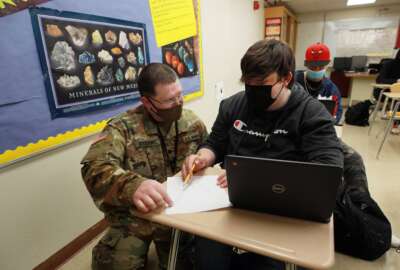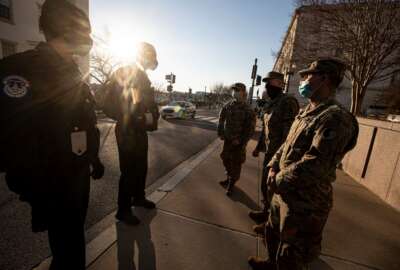
Army National Guard once again seeing less demand as COVID enters new phase
After two years of record high deployments, the Army National Guard may be seeing some relief.
After two years of record or near-record highs of deployment, the Army National Guard says it’s seeing its demand for soldiers declining in the United States and overseas, partly due to the wane of COVID-19.
The component currently has 41,600 soldiers deployed, according to Lt. Gen. Jon Jensen, director of the Army National Guard. That’s down from the historic high since World War II of 101,841 soldiers on June 6, 2020.
“What we see today is the beginning of a downtick of Army title 32 orders,” Jensen said during a Tuesday Center for a New America Security event.
Title 32 is used for federal authority over soldiers when they are on state-level activation.
Jensen said from the fall of 2020 to the summer of 2021, the Army National Guard had 15,000 soldiers supporting the COVID-19 mission. During Omicron, the Army National Guard saw that number rise again to as high as 16,000. Jensen said the demand for COVID deployments are starting to decrease once again.
The National Guard had its busiest two years in more than seven decades as it tried to keep up with overseas deployments, COVID-19, civil unrest, natural disasters and protecting the Capitol building after it was attacked by supporters of former President Donald Trump.
“I’d like to think our operational tempo is going to lessen primarily because at some point we’re going to leave a COVID-19 environment,” Jensen said. “If you take that off our plate right now, that would reduce our operational tempo by a factor of about 15,000 soldiers a month. I think when we see the end of COVID-19 support, we will go back to more of a traditional role of responding to emergent emergencies that are short duration.”
Jensen said COVID’s challenge is that it is a long-term issue, one that has had soldiers doing everything from providing tests to administering shots to substitute teaching.
Despite the high demand, Jensen said the Army National Guard is keeping up with its end strength numbers. That’s due to lower attrition and higher retention during the pandemic.
Jensen said the Army Guard cannot rely on that retention bump once COVID-19 wanes further. One of the Guard’s biggest issues is keeping mid-career soldiers in the Guard.
“When I was a young major, you stuck around for that promotion to lieutenant colonel with the hope that maybe you might be a battalion commander,” he said. “Nowadays, we don’t necessarily always see that. We see people as they enter their 20th year. They’re at that point in their life where their kids are at that age where they’re very active in school and extracurricular activities. They’re at that point of their civilian career where their civilian employer is beginning to ask more and more of them, and we understand that competition.”
Jensen said the Army Guard itself is going through transformation as well. Like the active duty Army, the Army National Guard is moving away from bring brigade-centric in its push to be more multi-domain. The component is building new force structure to emphasize things like electronic warfare, cyber and even artillery.
Copyright © 2025 Federal News Network. All rights reserved. This website is not intended for users located within the European Economic Area.
Scott Maucione is a defense reporter for Federal News Network and reports on human capital, workforce and the Defense Department at-large.
Follow @smaucioneWFED





